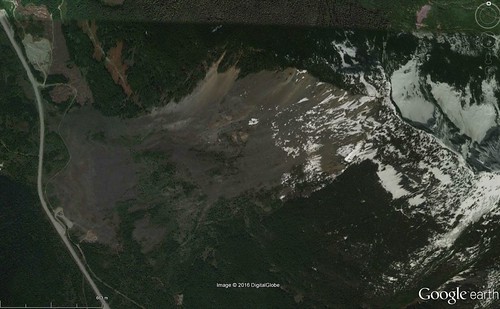Once again, the hard part was identifying the geological feature... the Dieldartunguvhev hot spring in the centre of the image - for more information about this spot, go to this link: Deildartunguhver thermal spring
Contest #561:

Rules, tips and previous WoGEs are collected by Felix on his http://woge-felix.blogspot.ca/ blog with a KML file available with all WoGEs.
I will invoke the Schott rule again: one hour delay for each previous win.
Published at 1625 UTC, April 25, 2016
No Schott rule - so I can leave what I found!
ReplyDeleteHope Slide, Canada
49°18'26.93"N 121°14'48.17"W
Hope Slide was the largest landslide ever recorded in Canada. It occurred in the morning hours of January 9, 1965 in the Nicolum Valley in the Cascade Mountains near Hope, British Columbia, and killed four people. The volume of rock involved in the landslide has been estimated at 47 million cubic metres.
The landslide was caused by the presence of preexisting tectonic structures within the southwestern slope of Johnson Ridge.The lower parts of the slide scar are underlain by felsite sheets while the upper parts of the slide scar are underlain by highly jointed Paleozoic greenstone beds.
Ongoing weathering and tectonic activity weakened the slide mass to the point where it had reached limiting equilibrium. Johnson Peak was the site of a previous smaller prehistoric rockslide.
Just what triggered the landslide remains unclear; the two so-called earthquakes were likely too small to trigger the slide and thus the seismic events were more likely caused by the impact of the landslide masses on the opposite valley wall.
Changes in groundwater condition is not thought to have played a role in the Hope Slide as the slide occurred during a protracted period of sub-zero temperatures in the winter, though some have suggested that freezing of seepage exit points may have caused an increase in water pressure at the toe of the slide.
I did invoke the Schott Rule but you've waited long enough to answer.
ReplyDeleteGood job again!
Andrew
Nice to read that! I'll post a new puzzle next morning.
ReplyDeleteThe new game is on: http://woge-elisa.blogspot.de/2016/04/where-on-google-earth-562.html
ReplyDelete